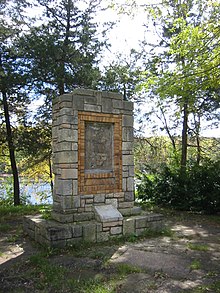St. Croix Boom Site
The St. Croix Boom Site is a National Historic Landmark in the US state of Minnesota . It is on the banks of the St. Croix River , upstream from Stillwater . The facility was established in 1856 after the former St. Croix Boom Company , which had operated a dam upstream near Marine on St. Croix , was dissolved. Isaac Staples and other greats in the logging industry bought the company and relocated to Stillwater.
Logs felled further up the river were branded by the company and the logs were floated downstream across the St. Croix River. In Stillwater they were fished out of the river and sorted according to their owners and then transported on to the sawmills in Stillwater. The company charged around 17 cents / m³ for handling the wood.
The St. Croix boom was quite a profitable business. Not only the handling fee, the generous amount of which was laid down in the company's articles of association, but also the skillful planning contributed to this, as the facility could be operated by a very small team out of season. The wood delivered brought high profits. During the 1870s, the felled trunks often accumulated over 25 km upstream over the summer.
The plant was in operation until 1914, when the areas on the river were completely cleared. The facility was then forgotten until it was rediscovered by a National Park Service employee . This was done in preparation for the river's designation as a National Scenic Waterway . In November 1966, the site was granted National Historic Landmark status. By 1975 the forest had grown back.
Today the Boom Site is a popular destination on the St. Croix River. It lies at the top of Lake St. Croix, the wide stretch of river that stretches from Stillwater to Prescott , Wisconsin , where the river joins the Mississippi River .
An information board originally indicated the importance of the facility:
“Before 1914, it was the center of logging and processing activities in this region for more than half a century. Millions of logs from Upper St. Croix and its tributaries have been collected, sorted, and rafted here to be later sawn into sawn timber and products. More logs were handled here than at any similar place in this area. 1940. "
This billboard was damaged and, due to budget cuts in the Minnesota Department of Transportation , the sanitary facilities and parking lot on the edge of this historic landmark closed in October 2005. That is why the property was placed on the watch list of the National Historic Landmark Program.
Web links
- Time and the River: A History of the Saint Croix ( Memento December 17, 2004 on the Internet Archive ) ; National Park Service website
- Two recordings from 1964 . (PDF file; 238 kB)
Individual evidence
- ↑ a b Stephen Lissandrello: National Register of Historic Places Inventory-Nomination: St. Croix Boom Site (PDF; 269 kB) National Park Service. July 28, 1975. Retrieved February 16, 2011.
- ↑ Listing of National Historic Landmarks by State: Minnesota. National Park Service , accessed August 16, 2019.
-
^ Minnesota History Along the Highways: A Guide to Historic Markers and Sites . Minnesota Historical Society , Saint Paul, Minnesota 2003, ISBN 0-87351-456-4 . .
Center of log and lumbering activities in this region for over half a century prior to 1914. Here millions of logs from the upper St. Croix and tributaries were halted, sorted, and rafted, later to be sawed into lumber and timber products. More logs were handled here than at any similar place in this section. 1940.
- ↑ St. Croix Boom Site . In: National Historic Landmark summary listing . National Park Service . Archived from the original on April 3, 2008. Info: The archive link was inserted automatically and has not yet been checked. Please check the original and archive link according to the instructions and then remove this notice. Retrieved January 9, 2008.
Coordinates: 45 ° 4 ′ 41 ″ N , 92 ° 47 ′ 53 ″ W.

